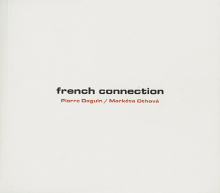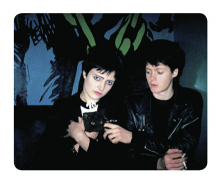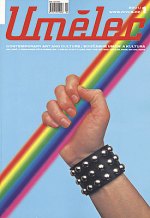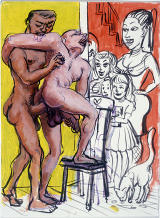| Zeitschrift Umělec 2003/1 >> Baedecker’s guide alias Roman c(t)orso | Übersicht aller Ausgaben | ||||||||||||
|
|||||||||||||
Baedecker’s guide alias Roman c(t)orsoZeitschrift Umělec 2003/101.01.2003 Marek Pokorný | kommentar | en cs |
|||||||||||||
|
"“Actually there is nothing as difficult as keeping on good terms with a Roman lady. Pride struggles all the time; with a little love one may awaken in her.”
Stendhal, Diary, Roma, August 5, 1832 Notwithstanding that the role of contemporary art may in today’s Italian society be — except the non-comparable capital strengths — as doubtful as in the Czech Republic, there is no doubt that this is not a question of a negligible item in the wonderful itinerary we meet when walking the Apennines peninsula. At first sight it is, nevertheless, obvious how fundamental is the difference between the standard of northern Milan, Trento-Rovereto, Venice under a periodical revival and the rest of Italy, consisting above all in the variety and manner of how the use of visual art is made and integrated in the cultural infrastructure of individual towns. Though the domestic community and some other people are bored by the northern centres claiming that the Roman scene has been reviving over the last two years, this kind of declaration must be discounted in spite of some distinctive differences when compared to 2000. The examples given below might explain why such expectations are still alive, however the potential and endeavour of the domestic community as well as the lining-up in international activities are characterized rather by provisional arrangements than by stable involvement in equal exchange. Into the structure of private galleries, the fame of which comes from the 60´s and the beginning the 70´s of the twentieth century (Bonomo, II Segno, Primo Piano) the Galeria Valentina Moncada was vigorously incorporated in the mid 90´s. Its owner studied at the Whitney Museum of American Art in New York and later she started boosting the performance of young British art in particular and, at same time, making opportunities for a rising generation of Italian artists (Luca Pancrazzi, Alessandra Tesi, Luisa Lambri, Marco Samoré). As to more recent projects, the names of Magazzini d´arte moderna or Galeria S.A.L.E.S. (Botto e Bruno, Avish Khebrehzadeh, Euan Mac-donald and Wolfgang Tillmans) are some of the most brilliant and steadfast ones. Within the last year they have been joined by the ambitious Gallery Lorcan O´Neil established by the former assistant of The White Cube in London and Tony Webster’s project called RomaRomaRoma. Volume! Gallery, goes through good times and bad, within its program you can meet Francois Morelet with Olaf Nicolai or Jorge Peris. An attempt to localize the galleries’ quarters can be traced in Trastavere Street (south of the Vatican) where the RomaRomaRoma project, Volume!, S.A.L.E.S. and the Lorcan O´ Neil gallery are situated. But this is rather a coincidence than an artistic quarter germination. By contrast the AutoriCambi gallery headed by Matteo Boetti is located in the neighbourhood of the Basilica Santa Maria Maggiore and via Merulana made famous by the novel of Carlo Emilio Gaddy. For slightly more than a year the functioning gallery has been striving to implement a private commercial model of not only sales and a promotional unit but also co-working on the production of artistic projects in the rather mundane Roman world. Most of the displayed works have been created in close fellowship with the gallery (there are also multiplex series among the displayed projects). Mr. Luca Buvoli, a native of the Italian Brescia now living in New York, is the latest artist displayed in AutoriGambi. His deprecating project Dov´é la Vittoria (Where is the Victory?) goes back to the Roman tradition of futurism and its outcome in the quasi-official creative language of some artists in the fascist epoch. Buvoli mythologizes flying, which has lost its general human appeal by using futurism and militant adoration of the technique itself and has become an ideologically abused theme. Using a mosaic as one of the significant elements is, in fact, an allusion to the endearment of this technique in the late 30´s. In connection with this and from the formal point of view focusing on another significant player, the Roman artist Achille Perilli, who has been unobtrusively put down for his consistent and uncompromising attitude, might be considered. Society after the Second World War and its existential position was characterized by the themes of techniques and world mechanization resisting the impacts of futurism unless leaving the Utopian vision of Italy, namely not ending the avantgarde in left-wing dada, constructivism and surrealism. After the Palazzo delle Esposizioni closed at the beginning of the 20th century, which was beneficial to contemporary art, two other institutions attracted attention by their dramaturgic purity approach and ambitions exceeding a one-year horizon. Both pride themselves with easily memorized names that are graphically significant. The older used to be originally a Roman gallery of modern art — something like the Gallery of Prague — lodged in the former brewery of the Peroni brand. After renaming within the last year it is now known as MACRO — Museum d´arte contemporaneo Roma (Roman Museum of Contemporary Arts). The rebuilding of the brewery has not been very successful and the residues of post-modern styles combining marble with glass and technical metals impedes both visitors´ mobility and, in particular, space separation for challenging exhibition projects as in the case of last year’s Tribú dell´ arte (Art Tribes), headed by Achille Bonito Oliva, the doyen of the Italian scene and Loráno Hedgy from the Museum of modern Arts in Vienna who were also the trustees. After a long break MACRO returns with three monographic presentations, the pivotal one of which is retrospectively devoted to Tony Cragg, the British sculptor. But more interesting and really worthwhile are the two smaller exhibitions marking the debuts of a young painter Cecily Brown and particularly Simon Starling, both British artists whose intelligent and conceptual linkage in its reasonability exceeds the more visible works displayed in Venice (Fiat 126). Starling works with lining up two places, relevant to the exhibition, namely Berlin where he lives and Rome as a destination of the traditional “Italian path” in general, and also with the “ready-made” concept, which he transforms to “made-ready.” A part of the displayed works reflects the German tradition and morphology founded by Goethe that incited, among other things, an interest in flower designs used in decorations and art-industrial creations. Starling converts the details of flower pictures into small three-dimensional statues together with some detailed bronze replicas made by Karl Blosfeld, an assistant of Moritz Meurer from Berliner Kunstgewerbemuseum, during his educational journey to Rome in 1892. Furthermore I would add that there were other replicas of Blossfeld pictures made by the Spanish artist Carlos Fortencumbera to see in the Roman Palazzo delle Esposizioni. While Fortencumbera focuses on identity illusion, Starling strives to visualize analogies between the morphological structures admired by Blossfeld and nowadays used articles — bicycle parts are displayed with reference to Duchamp. Another of Starling´s displayed works has the same affect, which deconstructs the design of Poul Hennings. A former slaughter-house from the turn of the 19th and 20th centuries has become a new spatial acquisition for MACRO, which acquired a convincing atmosphere for large presentations after an elementary renovation (the renovation is not technically perfect not because it was not possible but the renovator had no sense of perfection). At the moment there is an exhibition confronting photographs of well-known Andreas Gursky with projections of an American singer Michal Rovner originating from Israel (see the Israeli pavilion of the Venice Biennale). The next ambitious project that should be mentioned started in 1999 by the adaptation of a former casern to a fully functioning centre of contemporary arts. The name is, of course, not a matter of great importance and so when you are confronted with a compact significant abbreviation MAXXI, it belongs to the Roman “Museum in progress,” in other words the National Museum of the 21st century due to open in 2005. Prior to definitely setting the name another preparatory institution DARC (Direzione generale per l´architettura e l´arte contemporanee — General Directory for contemporary art of architecture) guaranteed and promoted acquisitions and programs and awarded prizes for contemporary Italian arts; the finalists will receive their awards at the Venice Biennale (Avish Khebrehzadeh, Charles Avery, Sara Rossi, Carola Spadoni). A tender for the architectural solution of MAXXI was won by the project from the well-known representative of deconstructive architecture, Miss Zaha Hahih, and in 2001 this brand new gallery was launched with a display of works that received a nomination for the Italian Contemporary Arts Award (Vanesa Beecroft, Eva Marisaldi, Liliana Moro etc.). The dramaturgy covered by the curator Mr. Paolo Colombo at the moment have so far involved several successful confrontations of Italian and foreign artists. The meeting of Eva Marisaldi and Michael Raedecker might be seen as the most successful. The recent group exhibition of artistic projects from northern Europe has not fared so convincingly despite the fact that the remarkable 3D Popcorn projection of the Finn Liisa Lounilla, also representing her country at this year’s Biennale in Venice, was featured there. Right now acquisitions are taking place, including Zen’s conscience video created by William Kentridge for his own Handspring Puppets Company according to his own adaptation of the famous novel of the Italian writer Svev. Also works by Kary Walker, Francise Alys and Michael Raedecker merit a mention. It’s almost impossible to find any marks of movement of futuristic origins from the beginning of the 20th century in today’s Rome. But disappointment would not be adequate when looking around the city living by the picturesque ruins and the official architecture of the thirties. When looking back at the beginning of the 90’s of the past century the Roman scene — at least as far as presentations and exhibitions are concerned — is booming now. Rather than strength in talents or firm concepts it might be observed within the activities of the numerous start-up public-service institutions, new private galleries and — finally — foreign cultural centres hosted by Rome because of the pretentious academic buildings from the beginning of the 20th century and the pilgrimage tradition of the centre of the Christian world in the 19th century. We must not omit Austrians, Swiss and Japanese, representing superior authors, who are trying to be a part of this scene. An exceptional role is played by the British School of Rome which has just rounded off the series of projects for Rome by the installation of a neon inscription created by Martin Creed placed on the façade of the British Academy building reading: “Everything is going to be alright.” Va bene. "
01.01.2003
Empfohlene Artikel
|
|||||||||||||
|
04.02.2020 10:17
Letošní 50. ročník Art Basel přilákal celkem 93 000 návštěvníků a sběratelů z 80 zemí světa. 290 prémiových galerií představilo umělecká díla od počátku 20. století až po současnost. Hlavní sektor přehlídky, tradičně v prvním patře výstavního prostoru, představil 232 předních galerií z celého světa nabízející umění nejvyšší kvality. Veletrh ukázal vzestupný trend prodeje prostřednictvím galerií jak soukromým sbírkám, tak i institucím. Kromě hlavního veletrhu stály za návštěvu i ty přidružené: Volta, Liste a Photo Basel, k tomu doprovodné programy a výstavy v místních institucích, které kvalitou daleko přesahují hranice města tj. Kunsthalle Basel, Kunstmuseum, Tinguely muzeum nebo Fondation Beyeler.
|




































 Potsdamer Str. 161 | Neu Divus in Zwitschermaschine, galerie und buchhandlug in Berlin! | Mit U2 nach Bülowstraße
Potsdamer Str. 161 | Neu Divus in Zwitschermaschine, galerie und buchhandlug in Berlin! | Mit U2 nach Bülowstraße
Kommentar
Der Artikel ist bisher nicht kommentiert wordenNeuen Kommentar einfügen